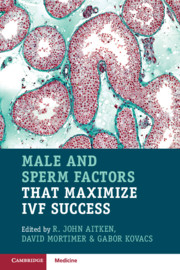Book contents
- Male and Sperm Factors that Maximize IVF Success
- Male and Sperm Factors that Maximize IVF Success
- Copyright page
- Contents
- Contributors
- Chapter 1 Sperm Selection for ART Success
- Chapter 2 New Horizons in Male Subfertility and Infertility
- Chapter 3 Chromosome Abnormalities and the Infertile Male
- Chapter 4 The Effect of Endocrine Disruptors and Environmental and Lifestyle Factors on the Sperm Epigenome
- Chapter 5 Lifestyle Factors and Sperm Quality
- Chapter 6 The Effect of Age on Male Fertility and the Health of Offspring
- Chapter 7 The Assessment and Role of Anti-sperm Antibodies
- Chapter 8 FSH Treatment in Male Infertility
- Chapter 9 Antioxidants to Improve Sperm Quality
- Chapter 10 The History of Utilization of IVF for Male Factor Subfertility
- Chapter 11 The Case Against Intracytoplasmic Sperm Injection for All
- Chapter 12 Perinatal Outcomes from IVF and ICSI
- Chapter 13 Artificial Insemination with Partner’s Sperm for Male Subfertility
- Chapter 14 Obstructive Azoospermia: Is There a Place for Microsurgical Testicular Sperm Extraction?
- Chapter 15 Should Varicocele Be Operated on Before IVF?
- Chapter 16 Donor Insemination: Past, Present and Future Perspectives
- Chapter 17 DNA Damage in Spermatozoa
- Chapter 18 Prevention of Male Infertility: From Childhood to Adulthood
- Index
- References
Chapter 2 - New Horizons in Male Subfertility and Infertility
Published online by Cambridge University Press: 24 May 2020
- Male and Sperm Factors that Maximize IVF Success
- Male and Sperm Factors that Maximize IVF Success
- Copyright page
- Contents
- Contributors
- Chapter 1 Sperm Selection for ART Success
- Chapter 2 New Horizons in Male Subfertility and Infertility
- Chapter 3 Chromosome Abnormalities and the Infertile Male
- Chapter 4 The Effect of Endocrine Disruptors and Environmental and Lifestyle Factors on the Sperm Epigenome
- Chapter 5 Lifestyle Factors and Sperm Quality
- Chapter 6 The Effect of Age on Male Fertility and the Health of Offspring
- Chapter 7 The Assessment and Role of Anti-sperm Antibodies
- Chapter 8 FSH Treatment in Male Infertility
- Chapter 9 Antioxidants to Improve Sperm Quality
- Chapter 10 The History of Utilization of IVF for Male Factor Subfertility
- Chapter 11 The Case Against Intracytoplasmic Sperm Injection for All
- Chapter 12 Perinatal Outcomes from IVF and ICSI
- Chapter 13 Artificial Insemination with Partner’s Sperm for Male Subfertility
- Chapter 14 Obstructive Azoospermia: Is There a Place for Microsurgical Testicular Sperm Extraction?
- Chapter 15 Should Varicocele Be Operated on Before IVF?
- Chapter 16 Donor Insemination: Past, Present and Future Perspectives
- Chapter 17 DNA Damage in Spermatozoa
- Chapter 18 Prevention of Male Infertility: From Childhood to Adulthood
- Index
- References
Summary
Male infertility is a common condition estimated to be a contributory factor in as many as 50% of couples experiencing problems with conception. It is also a key catalyst for the increasing uptake of assisted reproductive technologies (ART). Traditionally, andrological practice has relied on the use of ostensibly descriptive criteria; seeking to define a male’s fertility status based on the number of motile, morphologically normal spermatozoa present in their ejaculate. Notwithstanding the widespread adoption of such measures, over time we have come to appreciate their limitations and that fertility is more accurately predicted on the basis of sperm quality. This realisation poses the fundamental question of what constitutes a high-quality, fertilisation competent spermatozoon. Here, we consider recent advances in our understanding of the mechanistic basis of sperm function that are driving innovations in our ability to diagnose and treat male infertility, thus optimising outcomes for the management of male fertility.
- Type
- Chapter
- Information
- Male and Sperm Factors that Maximize IVF Success , pp. 15 - 27Publisher: Cambridge University PressPrint publication year: 2020
References
- 1
- Cited by



